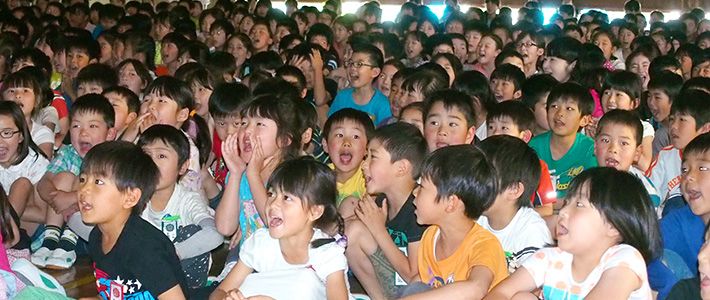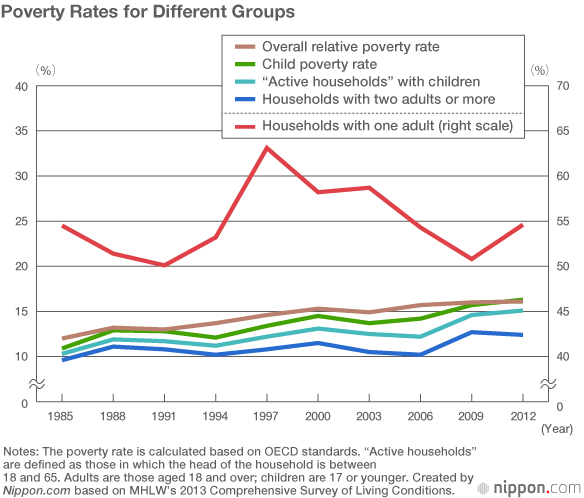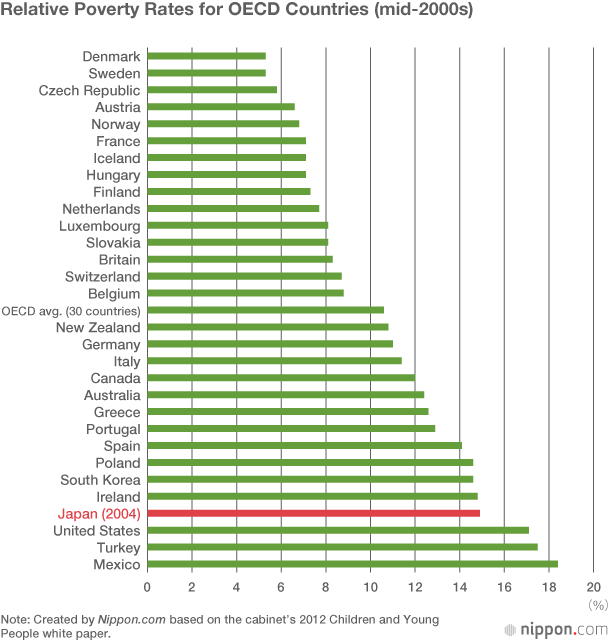
Japan’s Worsening Poverty Rate
Politics Economy Society- English
- 日本語
- 简体字
- 繁體字
- Français
- Español
- العربية
- Русский
One in Six Japanese in Relative Poverty
In July 2014, the Ministry of Health, Labor, and Welfare announced the findings of its 2013 Comprehensive Survey of Living Conditions. The report noted that Japan’s relative poverty rate—the proportion of people with net income below a defined threshold—was 16.1% in 2012. The threshold, calculated by MHLW based on OECD standards, in 2012 was defined as ¥1.22 million, half of the median equivalent disposable income.(*1) The child poverty rate, for children under 18 living in these households, was 16.3%. Both figures are the highest ever recorded.
This means that one in six Japanese people are living in relative poverty. In the survey, 59.9% of households responded that they found life financially tough. The record poverty rate is believed to be due to such factors as the drop in income for families with children over a protracted period of deflation and the increase in single-mother households, in which mothers often have low-paying, irregular employment.
Government Measures to Tackle Child Poverty
Alarmed by the record high child poverty rate, in August 2014 the government prepared its first set of policies to tackle the problem. These include measures to reduce the burden of paying for education and help in finding jobs for parents, as part of efforts to prevent poverty being passed down from generation to generation.
Following the chaotic postwar period, when many struggled to find adequate food and shelter, poverty was alleviated by economic growth. By the 1970s, there was a sense among many Japanese people that they were living in a country of “a hundred million people, all middle class.” However, economic divides opened up again in the 1990s, after the collapse of the bubble economy, as persistent economic stagnation led to companies trimming their workforces and brought about an increase in the number of employees without seishain, or “regular employee,” status. People started talking about “winners” (kachigumi) and “losers” (makegumi) in Japan.
Poverty Rate Fourth Highest Among OECD Countries
The nation’s poverty rate is high compared with other developed countries. Statistics from the Organization for Economic Cooperation and Development show that in the mid-2000s Japan’s relative poverty rate was fourth highest (15%) among the 30 OECD countries after Mexico (18.5%), Turkey (17.5%), and the United States (17%). The lowest rate was in Denmark (5%). Since around this time, Japan’s relative poverty rate has steadily increased. Today it remains well above the OECD average.
The MHLW’s 2012 white paper compared Japanese indexes related to fairness with those of other countries. It found that Japan’s relative poverty rate was on an upward trend, its Gini coefficient(*2) was higher than the OECD average, there was a great difference between employment rates for men and women, its long-term unemployment rate was higher than the OECD average, and there was a major disparity between male and female income.
The report concluded that Japan’s fairness indexes showed poor performance overall, reflecting problems in the present levels of income distribution, equal opportunity, and individual social independence. To tackle income and economic divides, the nation will have to undertake comprehensive discussion on the current state of employment, public assistance, public pensions, the minimum wage, and related issues. Preventing further social disparity is a vital issue for Japan now.
Absolute Poverty Rate Decreasing
The absolute poverty rate, as defined by the World Bank, is a way of measuring another kind of poverty, vastly different from that seen in Japan and other OECD countries. The World Bank describes those with income equivalent to less than $1.25 per day as living in absolute poverty. The standard is used when referring to people in developing countries who do not have enough money to buy basic daily necessities.
The figure of $1.25 per day was set by the World Bank in 2008 based on the average of poverty thresholds for the world’s poorest countries. As of 2008, its statistics showed that 1.29 billion people, or 22% of the developing world, were living in absolute poverty. However, this number was much reduced from 1.94 billion in 1981. From a global perspective, absolute poverty is decreasing as a result of efforts by the World Bank and other international actors, but in the developed world, divides between the poor and the wealthy are widening.


Banner photo: © Jiji
(*1) ^ Disposable income (household income minus tax, social insurance, and similar payments) divided by the square root of the number of household members.
(*2) ^ An index of income distribution disparity varying between 0 and 1. The closer the coefficient is to 0, the greater the level of income equality; the closer it is to 1, the greater the level of income disparity.